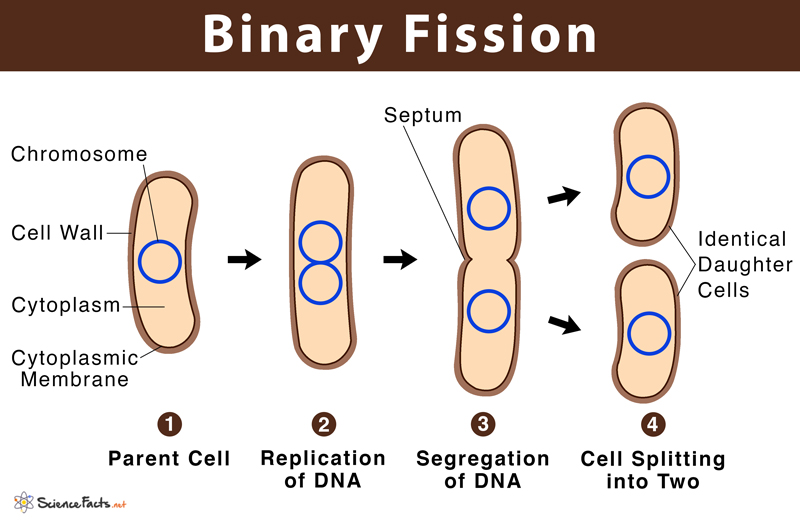Binary Fission
What is Binary Fission
Binary Fission, meaning ‘getting divided into half’ is a type of asexual reproduction where a single living cell grows twice its size and then splits to form two identical daughter cells, each carrying a copy of the parent cell’s genetic material.
Examples of cells that use binary fission for division
Bacteria, archaea, and cyanobacteria (prokaryotes), as well as amoeba and Paramecium (eukaryotes) use binary fission as their primary mode of reproduction. Some cell organelles like mitochondria also undergo cell division by this process.
Characteristics
It is a fast process where the exact speed depends on several growth parameters such as availability of nutrients, temperature, moisture, population, and the number of organisms.
For example, the bacterium E. coli typically divides once every 20 minutes at 37 °C, so an entire population can become double in that time and temperature. This can be practically related in cases of food spoilage where nutrients and moisture present in the food stimulates bacterial growth through binary fission, eventually making the food unsuitable for consumption.
Steps: How Does Binary Fission Work
Binary Fission in Prokaryotes
All the genetic information of a prokaryotic cell is stored in a single DNA molecule,in the specialized region of the cell cytoplasm called nucleoid. As the cell approaches cell division, the DNAstarts to gradually unfold, making way for the cell division machinery to assemble.
- Replication of DNA: The circular DNA of the parent cell is copied entirely using a set of enzymes
- Growth of Cell: This is the preparatory phase in which the cell starts to grow, becoming almost double in size. A special protein called FtsZ participates in this phase to help protect the parent DNA from damage during cell division. Thus the process of binary fission is also called FtsZ-dependent fission.
- Segregation of DNA: Here the cell elongates, as a new cell wall or septum starts to develop in the middle of the cell, resulting in complete separation of DNA.
- Cell Splitting: The cell wall formation is complete as the cell splits along the middle of the septum, dividing the cell into two daughter cells. Each daughter cell gets an equal half of the nuclear material and other cell organelles.
Binary Fission in Eukaryotes
It is not as common in eukaryotic cells as it is in prokaryotes. The process is also much more complex in the former due to the presence of large genetic material and many cell organelles. However, the main steps are the same as described in prokaryotes, involving the FtsZ protein.
Types of Binary Fission
According to how the cells divide, binary fission can be of four types:
- Irregular: The division of cytoplasm can occur in any direction, but is always perpendicular to the plane of division of chromosomes. Example – Amoeba
- Longitudinal: The division of cytoplasm takes place along the longitudinal axis. Example – Euglena
- Transverse: The division of cytoplasm takes place along the transverse axis. Example – Paramecium
- Oblique: The division of cytoplasm takes place obliquely. Example – Ceratium
Advantages and Disadvantages of Binary Fission
Advantages
- It is a fast process
- It only requires a single organism instead of two mating partners, for reproduction to happen
Disadvantages
- No variation in reproduction and thus all cells are identical with the same genetic information
- Incapable of adaptation, which increases the risks of extinction for the organism
Binary Fission vs. Mitosis
Differences
| Basis | Binary Fission | Mitosis |
| Definition | Type of asexual reproduction, in which single-celled organisms make a copy of themselves | Part of cell cycle in eukaryotes where the mother cell divides to produce to identical daughter cells |
| Time needed | Simple and rapid | Complex process that requires more time |
| Where it Occurs | In prokaryotes and also in some protists and eukaryotic organelles | Only in eukaryotes |
| Spindle Formation | Not necessary | Necessary |
| Stages | Replication, growth, segregation, and splitting | Prophase, metaphase, anaphase, and telophase |
| Reliability | Not completely reliable. Daughter cells sometimes get unequal numbers of chromosomes | Much more reliable as chromosome number is maintained throughout the process |
| Concurrency | DNA replication and cell division occur at the same time | DNA replication is completed long before cell division |
| Main Functions | Reproduction | Reproduction, repair, and growth |
Similarities
- Both are used, by different groups of organisms, for the purpose of asexual reproduction
- The genetic material gets divided into two equal parts
- Cytoplasmic division occurs
FAQs
Ans. Since viruses are not cells, they do not reproduce by binary fission.
-
References
Article was last reviewed on Thursday, February 2, 2023




